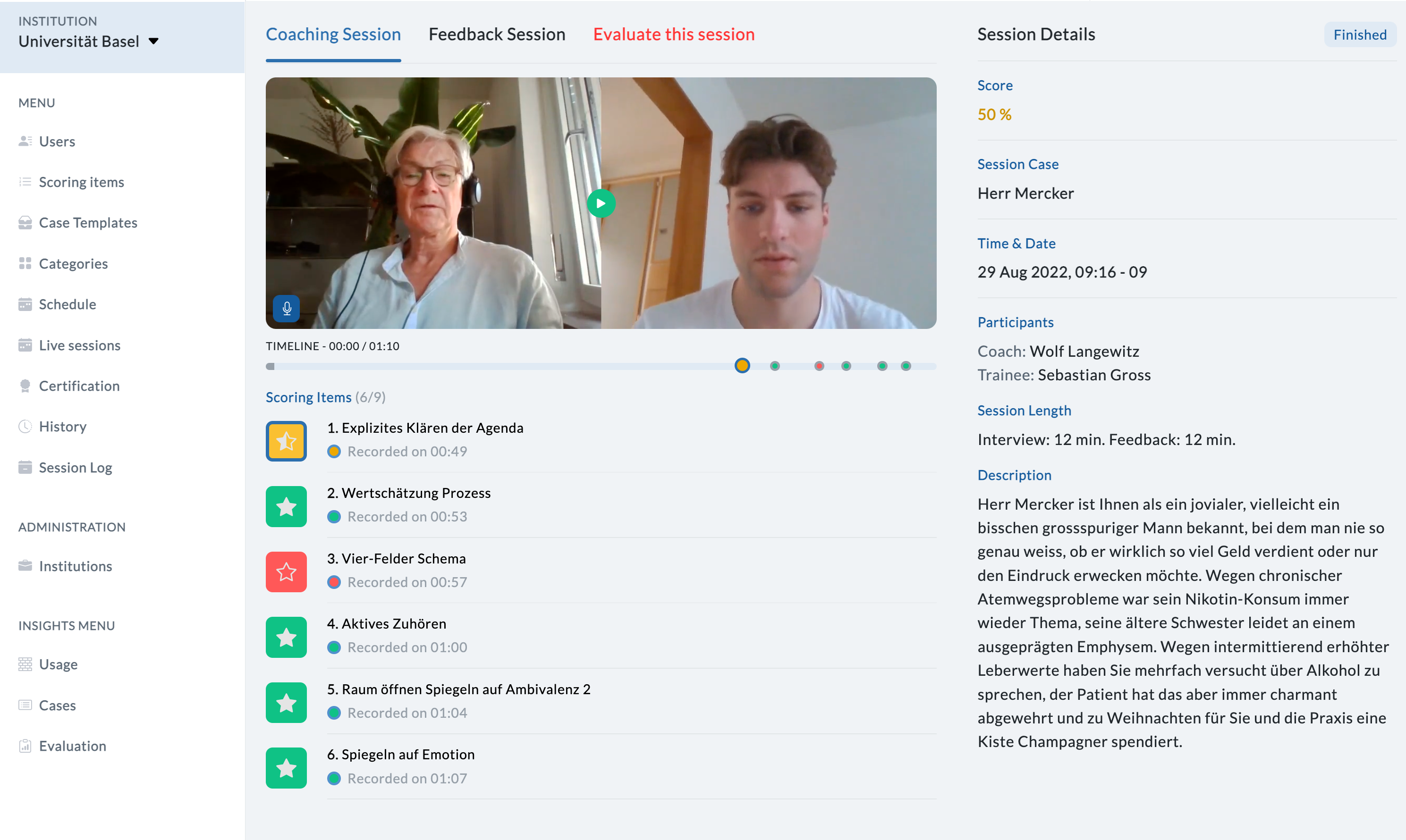SoCoCo
Social and Communication Competence
The platform to train your team members social and communication competences through structured training sessions with clear feedback protocols and individual scoring as well as integrated recordings for shared reflection and growth.
Start using SoCoCo
SoCoCo is available either on a per-project basis including case-design and train the trainer services, or on an institution level where you & your team can work independently with SoCoCo.
SoCoCo - Project Based
A project team will consists of team members from the institution that requests an intervention and members from the SoCoCo® team. The project team defines typical problem situations and indicators of professional behaviour (“How would you identify a person who successfully took part in a training activity?”). The description of problem situations and indicators of professional behaviour are transferred to SoCoCo®. This information informs standardised actors to present problem-specific cases and to give structured feedback to trainees.
SoCoCo® team members assist in translating problem situations into problem-specific cases and in the transformation of indicators of professional behaviour into feedback items.
When problem cases and feedback items are agreed, SoCoCo® is responsible for the training of standardized actors on and for the setup of scheduling facilities between standardized actors and trainees.
During the intervention, SoCoCo® will collect anonymised data of the performance of standardised actors and of the performance of trainees.
SoCoCo - Institution Based
This mode applies if an institution wants to act independently. This includes definition of problem cases and feedback items, casting and training of standardised actors, implementation of case descriptions and feedback items into SoCoCo®.
The SoCoCo® team will set up a new institution and provide training to new institution administrator(s).
SoCoCo®: How it works, identify problem areas and define training objectives
Training Request
A training request is normally triggered by critical feedback from patients/clients/customers/team members of an institution.
Critical feedback informs the definition of problem area(s), where improvement is deemed necessary.
Ex.: Within an organisation, members of teams A & B repeatedly report on the low quality of feedback from seniors or from other team members. In that case, low quality of feedback is defined as the problem area, improving feedback as the training objective.


Development of problem-specific feedback items
The project team discusses the institutions’ standards for professional behaviour in a problem situation. This standard is then translated into case-specific feedback items.
In some institutions a standard for professional behaviour will exist already, it must then be applied to the specific problem-case(s) as defined above. In other institutions, the definition of a problem area will trigger the search for a standard of professional behaviour that makes sense to representatives of an institution. This search is usually based on empirical findings from the literature. If a project is run in the project mode, WLWS will assist in finding and summarising empirical findings.
Development of problem-specific feedback items
The project team discusses the institutions’ standards for professional behaviour in a problem situation. This standard is then translated into case-specific feedback items.
In some institutions a standard for professional behaviour will exist already, it must then be applied to the specific problem-case(s) as defined above. In other institutions, the definition of a problem area will trigger the search for a standard of professional behaviour that makes sense to representatives of an institution. This search is usually based on empirical findings from the literature. If a project is run in the project mode, WLWS will assist in finding and summarising empirical findings.
SoCoCo®: Setting up cases, training actors
Once a professional standard is defined, this is applied to problem-specific case(s) to generate case-specific feedback items. Feedback items are used by standardized actors to structure a feedback session immediately following an interaction with the problem case.
Ex.: The project team agreed on the following list of professional behaviours: A critical feedback should be announced (feedback item 1). A clear agenda for the meeting should be defined (feedback item 2), a tentative time frame should be given (feedback item 3). Critical feedback should be based on observations (feedback item 4). Critical feedback is followed by a pause; the supervisor waits for the recipient to respond (feedback item 5). Depending on the recipient’s reaction – to be defined in the case description and demonstrated by the actor – a professional reaction could be: supervisor responds to the recipient’s emotion (feedback item 6). Supervisor summarises the aspects that would profit from a change plus the recipient’s responses (feedback item 7). Supervisor invites recipient to define goals for the next four weeks (feedback item 8). Supervisor adds his/her goals to be met within this period (feedback item 9). Supervisor closes the feedback session (feedback item 10).
Core element of SoCoCo® is the handling of video files. The video functionalities are organised from a learner and a coach/actor perspective
Live interactions between participants
If a standardised patient (a coach) and a trainee (a learner) meet on the application, they use their webcams plus microphones, similar to working with programs like Zoom or MS Teams. It is possible to invite other persons to observe the interaction, if e.g. a small group discussion should follow a training session.
Recording of video and audio files
When the SP starts a case and when the trainee has entered the system, the interaction is recorded on video. The trainee sees a full picture of the ‘case’ plus a small inlay screen showing himself or herself. Conversely, the SP sees a full picture of the trainee plus a list of scoring items to be used in that specific case. While the SP is interacting with the trainee, s/he clicks on the categories that apply to a certain behaviour and marks them as ‘well done’, ‘iffy done’, ‘not well done’.
When the interaction is over, a link is sent to the trainee through which the video recording is accessible.
Feedback session
In the feedback session, the SP usually starts with a general impression, then, invites the trainee to go through the video recording in more detail. If the SP clicks on a feedback item is shows up on the trainee’s screen in the colour of the grading. The corresponding video sequences can be shown, discussed and, if the trainee so wishes, replayed between SP and trainee using alternative behaviour.
At the end of the feedback session, another link is sent to the trainee that gives access to the recording of the feedback session.
